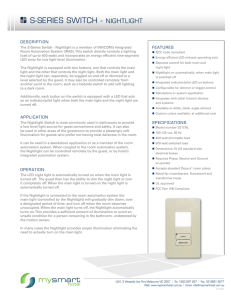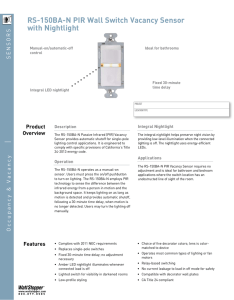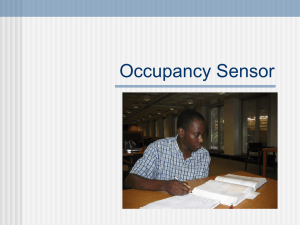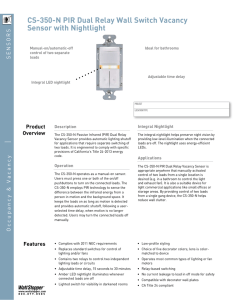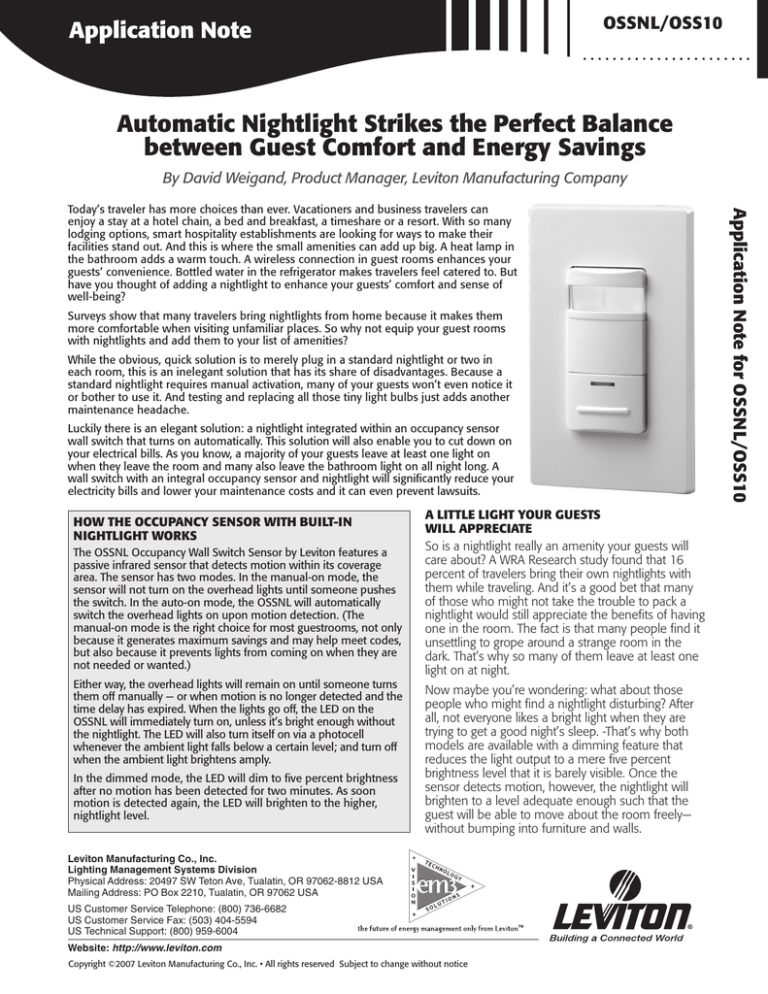
OSSNL/OSS10
Application Note
Automatic Nightlight Strikes the Perfect Balance
between Guest Comfort and Energy Savings
By David Weigand, Product Manager, Leviton Manufacturing Company
Surveys show that many travelers bring nightlights from home because it makes them
more comfortable when visiting unfamiliar places. So why not equip your guest rooms
with nightlights and add them to your list of amenities?
While the obvious, quick solution is to merely plug in a standard nightlight or two in
each room, this is an inelegant solution that has its share of disadvantages. Because a
standard nightlight requires manual activation, many of your guests won’t even notice it
or bother to use it. And testing and replacing all those tiny light bulbs just adds another
maintenance headache.
Luckily there is an elegant solution: a nightlight integrated within an occupancy sensor
wall switch that turns on automatically. This solution will also enable you to cut down on
your electrical bills. As you know, a majority of your guests leave at least one light on
when they leave the room and many also leave the bathroom light on all night long. A
wall switch with an integral occupancy sensor and nightlight will significantly reduce your
electricity bills and lower your maintenance costs and it can even prevent lawsuits.
HOW THE OCCUPANCY SENSOR WITH BUILT-IN
NIGHTLIGHT WORKS
The OSSNL Occupancy Wall Switch Sensor by Leviton features a
passive infrared sensor that detects motion within its coverage
area. The sensor has two modes. In the manual-on mode, the
sensor will not turn on the overhead lights until someone pushes
the switch. In the auto-on mode, the OSSNL will automatically
switch the overhead lights on upon motion detection. (The
manual-on mode is the right choice for most guestrooms, not only
because it generates maximum savings and may help meet codes,
but also because it prevents lights from coming on when they are
not needed or wanted.)
Either way, the overhead lights will remain on until someone turns
them off manually — or when motion is no longer detected and the
time delay has expired. When the lights go off, the LED on the
OSSNL will immediately turn on, unless it’s bright enough without
the nightlight. The LED will also turn itself on via a photocell
whenever the ambient light falls below a certain level; and turn off
when the ambient light brightens amply.
In the dimmed mode, the LED will dim to five percent brightness
after no motion has been detected for two minutes. As soon
motion is detected again, the LED will brighten to the higher,
nightlight level.
A LITTLE LIGHT YOUR GUESTS
WILL APPRECIATE
So is a nightlight really an amenity your guests will
care about? A WRA Research study found that 16
percent of travelers bring their own nightlights with
them while traveling. And it’s a good bet that many
of those who might not take the trouble to pack a
nightlight would still appreciate the benefits of having
one in the room. The fact is that many people find it
unsettling to grope around a strange room in the
dark. That’s why so many of them leave at least one
light on at night.
Now maybe you’re wondering: what about those
people who might find a nightlight disturbing? After
all, not everyone likes a bright light when they are
trying to get a good night’s sleep. -That’s why both
models are available with a dimming feature that
reduces the light output to a mere five percent
brightness level that it is barely visible. Once the
sensor detects motion, however, the nightlight will
brighten to a level adequate enough such that the
guest will be able to move about the room freely—
without bumping into furniture and walls.
Leviton Manufacturing Co., Inc.
Lighting Management Systems Division
Physical Address: 20497 SW Teton Ave, Tualatin, OR 97062-8812 USA
Mailing Address: PO Box 2210, Tualatin, OR 97062 USA
US Customer Service Telephone: (800) 736-6682
US Customer Service Fax: (503) 404-5594
US Technical Support: (800) 959-6004
Website: http://www.leviton.com
Copyright ©2007 Leviton Manufacturing Co., Inc. • All rights reserved Subject to change without notice
Application Note for OSSNL/OSS10
Today’s traveler has more choices than ever. Vacationers and business travelers can
enjoy a stay at a hotel chain, a bed and breakfast, a timeshare or a resort. With so many
lodging options, smart hospitality establishments are looking for ways to make their
facilities stand out. And this is where the small amenities can add up big. A heat lamp in
the bathroom adds a warm touch. A wireless connection in guest rooms enhances your
guests’ convenience. Bottled water in the refrigerator makes travelers feel catered to. But
have you thought of adding a nightlight to enhance your guests’ comfort and sense of
well-being?
Application Note
OSSNL/OSS10
.........................
STUDY PROVES DEVICE DRAMATICALLY LOWERS
ENERGY USE
The truth is that when people stay in hotels, they just don’t pay
attention to energy conservation. Obviously they’re not paying
for the electricity (you are) and besides, there are many times
they actually would prefer to leave a light or two on so they
don’t have to enter a dark room at night or so they can see
better if they have to get up from bed at night.
In fact, according to Sunbeam Hospitality and Andis Company,
about 45 percent of travelers leave on the bathroom light
when there is no nightlight available. Of course this ends up
costing the hospitality industry an awful lot of money every
year. Unfortunately, until now, there were no truly effective
solutions to address this issue in the past. Putting timers on
lights would cause lights to turn off on a rigid schedule that
might annoy guests, and even pose a risk to their safety at
times. And standard occupancy sensors could leave guests in
complete darkness when the devices timed out. Neither of
these options would have been very good for business. An
occupancy sensor with a built-in nightlight overcomes these
drawbacks. A few years back, the California Energy
Commission sponsored a Lawrence Berkeley National
Laboratory study of one of these devices in bathrooms at the
Doubletree Hotel in Sacramento, California. The findings were
definitive. Installing nightlight occupancy sensors in hotel
bathrooms produces significant energy savings, and reduces
maintenance costs including labor and light bulbs.
In the LBNL study, bathroom lights were on about four to five
hours per day (on average 4.4 hours) prior to installing the
sensor. This decreased to 1.5 to 3 hours (on average 2.4
hours) after the sensor was installed. That is a 46.5 percent
drop in usage! With an average load in the study of 180 watts,
the approximate savings per day per room was 360 kilowatthours. This translates into 33 dollars per guestroom at an
average price of 9.2 cents per commercial kilowatt-hour (the
average price in the U.S. according to the government).
The actual savings achieved in any given installation depends
on a variety of factors. One of the most influential
determinants is the size of the load being controlled by the
sensor, which may range from 50 watts for a single fluorescent
lamp to well over 200 watts for an incandescent vanity light.
Then, of course, there’s the cost of electricity, which varies
greatly across the country. The time delay period is another
important factor. The devices in the study were set to a
one-hour delayed off but a shorter time delay will result in
additional savings. (At Leviton, we think a 30-minute period
is the optimal setting for hospitality applications. Anything
shorter may end up eliciting complaints from guests.)
Usage patterns also impact savings. People tend to spend a lot
more time in their rooms when they travel for pleasure, as
opposed to on business. Since the study cited here was
conducted in a hotel with a primarily business clientele, it is
safe to assume that the benefits of installing a nightlight
occupancy sensor will be much greater for establishments
catering to vacationers.
But the savings don’t stop there. In addition to reducing
electricity bills, occupancy sensors extend bulb life. That means
fewer light bulbs to purchase and for maintenance staff to
change— and fewer complaints from guests.
NIGHTLIGHTS PREVENT ACCIDENTS
When a guest falls or crashes into something, not only might
you have an unhappy customer; you might also be facing an
expensive lawsuit. Improving lighting is widely acknowledged
as one of the best measures for preventing these incidents.
“Nightlights are proven to help prevent nighttime falls — the
number one cause of guest injury,” noted Harry Nobles,
industry consultant and former head of the AAA Lodging/
Dining Ratings Program. A person is much less likely to trip, fall
and get hurt when they can see where they’re going. And the
odds of injury certainly rise in an unfamiliar room—especially
with the elderly who are most likely to have compromised
night vision as well as a tendency to fall.
CONCLUSION
Its value as an amenity and its economic benefits combine to
make the nightlight occupancy sensor an attractive
option for the hospitality industry on the whole. Still some
applications will provide quicker returns on investments than
others. New construction applications will result in faster,
simple paybacks (taking only energy-related savings into
account) than will retrofit jobs.
The additional labor to install this sensor in new construction
(as opposed to a standard switch) is negligible; yet it may take
an electrician thirty minutes per device in a retrofit situation.
The Berkley Lab study estimated a simple payback at around
1.5 years for new hotels and 3.2 years for retrofit applications.
When you take into account the savings in the maintenance
area, and possibly incentives defraying the initial costs, the
payback period can be considerably shorter. Everything after
that point is gravy.
Leviton Manufacturing Co., Inc.
Lighting Management Systems Division
Physical Address: 20497 SW Teton Ave, Tualatin, OR 97062-8812 USA
Mailing Address: PO Box 2210, Tualatin, OR 97062 USA
US Customer Service Telephone: (800) 736-6682
US Customer Service Fax: (503) 404-5594
US Technical Support: (800) 959-6004
Website: http://www.leviton.com
Copyright ©2007 Leviton Manufacturing Co., Inc. • All rights reserved Subject to change without notice
G-7631/A7 sw


